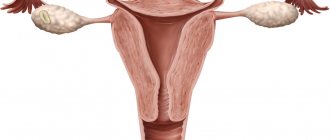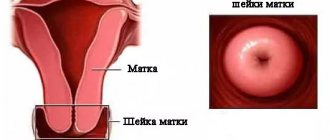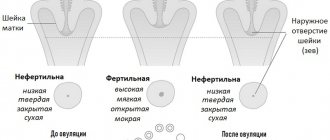Entry published by Oksyunechka · August 13, 2014
9
Girls, I don’t know what to think.. Help! Today it’s already 31 dc (or maybe 32 I don’t remember exactly). Before giving birth, the cycle was consistently 27 days, after B.. it was 30, then 27, and then it became 25-24 days. And today it’s already 31.. We don’t use protection because... we want more dolls, but there are not many chances for independent B(((My son was born with the help of doctors. I used to observe my cervical cancer before M. it was always large, low and loose. But with the appearance of a delay, my hands began to climb there and to the tests( what if it worked out?!) But on Monday the test was clear and today it’s the same... The cervical cavity is usually high and is sometimes slightly open, then closed and tight. I read that in those who have given birth, the external os is always slightly open. Last night the cervix was in the middle position and I honestly speaking, I thought that overnight she would reach the same condition as before M, but in the morning the MM became high, high and dense. At lunchtime she was just as high and visibly soft. What should I think? The test should already show something ?We wouldn’t want any kind of failure, etc. In the winter we are planning to go for crumbs.. I don’t have the opportunity to use hCG yet, and I’m afraid that I’ll just throw money away and that’s it, but it won’t solve the problem. It's probably too early to go, if B is there, they're unlikely to see her. In general, please advise! What should I do? We haven't breastfed for about 5 months.
Photo of the cervix by day of the cycle
This project was led by a 25-year-old woman. She has never given birth and has no history of STDs. Each photograph was taken at approximately 10:00 p.m., starting on the first day of the menstrual cycle. Throughout this project, she used condoms as a contraceptive method and also to prevent semen from being released during the photo shoot. She did not use tampons during her period.
This cycle is 33 days, which is the norm. The follicular phase of her cycle lasts until about 20–21 days. Favorable days for fertilization last several days from the 13th to the 21st day with ovulation on the 20th day. The luteal phase is 13 days (12–16 days is normal).
Above is the basal temperature chart for this cycle. As you can see, after ovulation on about the 20th day, her temperature began to rise due to increased progesterone, which in turn is produced by the corpus luteum. This temperature shift means that ovulation has already occurred.
She also monitored the position of the cervix throughout the entire cycle. Since the photo does not show whether the cervix is hard or soft, high or low. All this is clearly noticeable upon independent palpation. The uterus is tilted back (retroflexion), you may notice in several photos that the cervix is pointing upward. These are anatomical changes that are present in 20–30% of women, and most often a genetic trait.
Note the drop of blood and brown lump near the cervix (right). Perhaps from a stormy conversation on the same day, but later an endometrial polyp was diagnosed.
Hmmm... Meh... and this is for the night... but thanks anyway for such photos, I’ve never seen anything like this and, to be honest, I didn’t really understand anything. I'm probably the only one so stupid here... My husband is watching horror films, I left so as not to see how the heads
Cervical position
An experienced gynecologist can tell a lot about the state of the female body based on the position of the cervix. For example, about the imminent onset of menstruation, about ovulation, or even about pregnancy. Although no professional will talk about the beginning of pregnancy only on the basis of such an examination, but will prescribe additional examinations.
The position of the cervix during pregnancy can indicate possible complications. So, if it is very short (less than 2.5 centimeters), then measures should be taken to prevent premature birth or spontaneous abortion. If there are no risks, then further examinations of the cervix are not carried out. To assess the condition of the fetus, the woman will need to undergo an ultrasound.
Before giving birth, the position of the cervix can help you understand how ready the patient’s birth canal is for this event. Before giving birth, the cervix should allow at least one finger inside and be smooth. If it is long and clearly “goes back”, and the time to give birth has already come, then it is also necessary to take measures, otherwise fetal hypoxia may develop.
The condition of the cervix also helps in diagnosing cancer or precancerous conditions. Indeed, in the initial stages, a woman may not even suspect that something is threatening her health. And only competent behavior of a doctor can prevent dangerous consequences.
And finally, let’s not forget that even though we live in the 21st century, modern equipment, even today, is not available in every locality. But in these places women also suffer from infertility, as in large cities. Local doctors help such patients “calculate” the days suitable for conception by examining the cervix.
Ordinary women who want to become mothers should also have some information on this matter. After all, it will help determine the time of ovulation. And, let’s not hide it, I will be to many potential
Source
Possible complications
Delaying treatment and consultation with a specialist can lead to many complications. As a result of an enlarged cervix, the process of fertilization of the egg is complicated, and infertility develops. In the final stages of the disease, there may be a risk of developing malignant neoplasms.
If in the first stages the problem does not manifest itself symptomatically and does not cause inconvenience, then with its further development, discomfort, pain, bleeding, and discomfort while sitting and walking may occur.
If uterine enlargement occurs against the background of another gynecological disease, then without treatment it will progress and can cause the development of the following pathological processes:
- Frequent and heavy bleeding if the increase occurs against the background of uterine fibroids
- Leukoplakia
- Exacerbation of inflammatory processes in muscle tissue, during which scar defects may develop
- Formed cysts can rupture on their own, which causes the development of various degenerative processes
The cervix is high. Test negative, pregnancy?
17-DPO, BT-37.1°C. Ovulation is clearly visible, implantation retraction, 3-phase level, in the morning out of desperation I checked the cervix, rose high and barely touched it with my finger. Tested with a sensitivity test of 25-negative. At the moment, the lower abdomen is starting to pull, like before menstruation.
According to my schedule, I was pregnant every cycle))) for the sm to be informative, you need to monitor it for 1-2 cycles! Ovulation, again, could be later than the graph drew. There are two options: wait or blood test for hCG! Good luck
Staska, it was planned to donate blood for hCG today, but looking at the test I was disappointed... and the results will only be available next week(
You know, my friend’s tests also didn’t show anything until 6 weeks, although ovulation was confirmed on the 15th day of the cycle by ultrasound and tests for O and egg white, but the tests stubbornly didn’t show, and the rate was high, she just thought failure, and I stubbornly forced her to donate blood, when I donated everything immediately became clear, so donate hCG
I'm on my phone, so I can't see your chart, but count at least 12, or better yet 14, days from the day of ovulation and then do the test. But as long as bt is above 37, the probability b remains. I showed a ghost at 10dpo, but the test would have been at 10 and a ghost (though clearly visible).
NIKA1, according to my feelings, the shm was high when ovulation occurred. When conception happened closer to the babies, she sank low and became soft and soft
NIKA1, the schedule is good, but if ovulation was on the 21st day of the cycle, then today is exactly 14 DPO. If M does not start tomorrow and BT does not go down, you can take hCG, despite the negative tests.
Lerunka, thank you, as I see it, an ideal graph may not mean anything..((and it’s not even ideal to indicate pregnancy. A couple of brown drops have already come out, the temperature is t
Source
Cervix during pregnancy.
Girls, who knows how the cervix behaves during pregnancy. I heard somewhere that when pregnancy occurs, the cervix rises, becomes hard and closed, and when menstruation arrives soon, on the contrary, it drops lower, so that it can be easily felt. Girls at the beginning of their pregnancy, if it’s not difficult for anyone, take a look at how it’s going for you:
“All practicing gynecologists know what the cervix should be like before menstruation - a little softened, slightly open in women who have given birth. Whereas during pregnancy, on the contrary, it has a dense consistency and is located high in the vagina. The position of the cervix before menstruation is slightly lower. How to use the acquired knowledge in a situation? It is necessary to cut your nails short, wash your hands and insert 2 fingers deep into the vagina (it is better to wear disposable medical gloves first). There you will feel a tubercle - this is the cervix. All that remains is to decide what consistency it is and how far it is from the vaginal outlet.”
User comments
Guadeloupe, why is it written like that here?” Whereas during pregnancy, on the contrary, it has a dense consistency and is located high in the vagina.”?
I'll tell you how it was for me. I introduced Utrozhestan suppositories from the first day of the delay, i.e. from 3-4 weeks of pregnancy. I inserted it very deeply, so I know about the cervix. at such a short time, the cervix was dense, hard, long (about 4-5 cm), but not high. I finished inserting suppositories at 14 weeks. At this time, the neck had already risen so high that I could not reach it or touch it at all. during all this time the neck was just as tight (as in your description)
yes, at a short time it was close to the exit, I easily pushed the candle into the dead end near the cervix, and by 14 weeks I could no longer reach the cervix itself.
why do you need this
Source
Palpation of the uterus at home
Often girls, before going to the doctor, want to independently check their assumptions regarding the condition of the reproductive organ. With some basic knowledge and skills, you can identify its various conditions at home. Before menstruation, the cervix is slightly lower than during pregnancy. During pregnancy, the cervix is high, tightly closed, and the uterus itself has a loose structure.
It is impossible to judge the condition of an organ solely on the basis of palpation. For an accurate diagnosis, it is necessary to be examined by a doctor.
How to palpate
Self-palpation is carried out only for informational purposes or if it is not possible to visit a specialist.
Before menstruation, palpation is prohibited to avoid the risk of infection in the uterus.
If a woman decides to carry out such an event on her own, one should not forget about the possible disadvantages of this technique. To carry out palpation without any consequences, you must remember the following instructions from gynecologists:
- nails must be short and clean before performing this technique;
- hands should be thoroughly washed and dried;
- Before palpation, you should put on sterile latex gloves;
- gently insert the index and middle fingers into the vagina;
- carefully feel the rounded tubercle in the vagina, draw a certain conclusion for yourself based on the data obtained and remove your fingers from the vagina;
- take hygiene measures.
Disadvantages of palpation at home
Self-diagnosis of the cervix during menstruation is used only if necessary, as it has a number of disadvantages. These include the following:
- if hygiene measures are not observed, there is a risk of infection and infectious diseases;
- if palpation is carried out without due care, there is a possibility of damaging the cervix, which will cause erosion;
- it is difficult to determine exactly what the condition of the organ indicates due to the lack of experience and knowledge in this area;
- The need to see a doctor still does not disappear, since the woman cannot make an accurate diagnosis on her own.
It is very dangerous to independently diagnose the cervix during menstruation or its absence. Even if a woman has experience and theoretical knowledge in this area, she should not draw hasty conclusions. You should consult a specialist for a reliable diagnosis of the reproductive organ.
The cervix is open, almost 1 cm, but there are no periods, heavy discharge, no mucus, no odor... they are already 4 days late. but the question is that in the last couple of weeks there have been frequent constipation and nausea, which has a bad effect on the smells from the kitchen. If this is pregnancy, then it’s already the seventh week, although I had my period last month.
Woman.ru experts
Find out the opinion of an expert on your topic
Zinovieva Natalya Yurievna
Psychologist. Specialist from the site b17.ru
Dyachenko Elena Vladimirovna
Psychologist, Gestalt therapist in training. Specialist from the site b17.ru
Slobodyanik Marina Valerievna
Psychologist. Specialist from the site b17.ru
Nikulina Marina
Psychologist. Specialist from the site b17.ru
Sheludyakov Sergey
Psychologist, Clinical psychologist. Specialist from the site b17.ru
Trifonova Maria Anatolyevna
Psychologist. Specialist from the site b17.ru
Gundertailo Yulia Danilovna
Psychologist. Specialist from the site b17.ru
Vyacheslav Potapov
Psychologist, consultant. Specialist from the site b17.ru
Wrzecinska Eva
Psychologist. Specialist from the site b17.ru
Changes in the cervix before menstruation
What is the cervix like before menstruation? This is of interest to women who are trying to independently determine whether pregnancy has occurred or not. But you need to know not only what the uterus looks like before menstruation, but also what the uterus looks like after menstruation, as well as in the middle of the menstrual cycle. Only knowledge of the different states of the female reproductive organ at different periods of the cycle will allow us to draw correct conclusions about whether the cervix is located before menstruation or after conception with an embryo. It is not difficult to find out all this on your own, for which you will have to check your own vagina by touch. If this option does not suit you, you should not despair, because no one has canceled a trip to the gynecologist. A doctor is able to give a much more accurate assessment of a woman's condition.
Diagnosis of the disease
You can diagnose the disease yourself only at the last stage, when an enlarged cervix causes discomfort. To determine the pathology in a timely manner, you should periodically visit a gynecologist for a routine examination.
Cervical hypertrophy is diagnosed after a visual examination using palpation and speculum. Additionally, an intravaginal ultrasound examination may be prescribed to determine the structure of the organ tissue, its position and size. In addition, colposcopy and cytological examination of organ tissue are performed.
How the cervix changes before, during and after menstruation
It is not for nothing that gynecologists closely monitor the condition of the cervix - changes in this organ signal not only pregnancy, ovulation and the approach of menstruation, but also many infectious diseases and pathological abnormalities. Typically, the condition of the cervix is affected by endometriosis, cancer and other malignant tumors. Therefore, it is recommended to check the organ before menstruation and during ovulation.
What happens to the uterus before menstruation?
It is considered normal if the cervix before menstruation is hard to the touch and dry. During ovulation, on the contrary, it opens and becomes loose, preparing for fertilization. If pregnancy does not occur, then there will be critical days. The position of the cervix before menstruation is low. A completely different picture during ovulation and conception - the organ softens, becomes moist, and the pharynx opens slightly (pupil symptom). So the cervix before menstruation and during pregnancy are two different things. It is by these signs that a gynecologist can determine conception in the early stages. In addition, the fertilized uterus acquires a bluish tint, since during this period the number of vessels in the organ increases.
Also, many women are interested not only in what it feels like, but also in what the cervix looks like before menstruation. Of course, it is impossible to look into the vagina on your own and examine the organ, but you can determine its type by palpation - the uterus descends and can be easily palpated, and the pharynx contracts tightly. That is, if during ovulation the cervix looks like a tubercle with a dilated “pupil,” then before the critical days the “eye” of the organ is much smaller.
Cervix during menstruation
We found out what the condition of the cervix is before menstruation, now we will find out what it looks like directly on menstruation days. At this time, the pharynx expands slightly, as during ovulation, but
Our rulers of planners. Try it and tell us what you think!–>
* Dear friends! Yes, this is an advertisement, you have to spin like that!
Which of the pregnant women felt the cervix in anticipation of the next monster or pregnancy. What is she really like? I want to know the opinion in practice, otherwise I won’t understand anything in theory.











